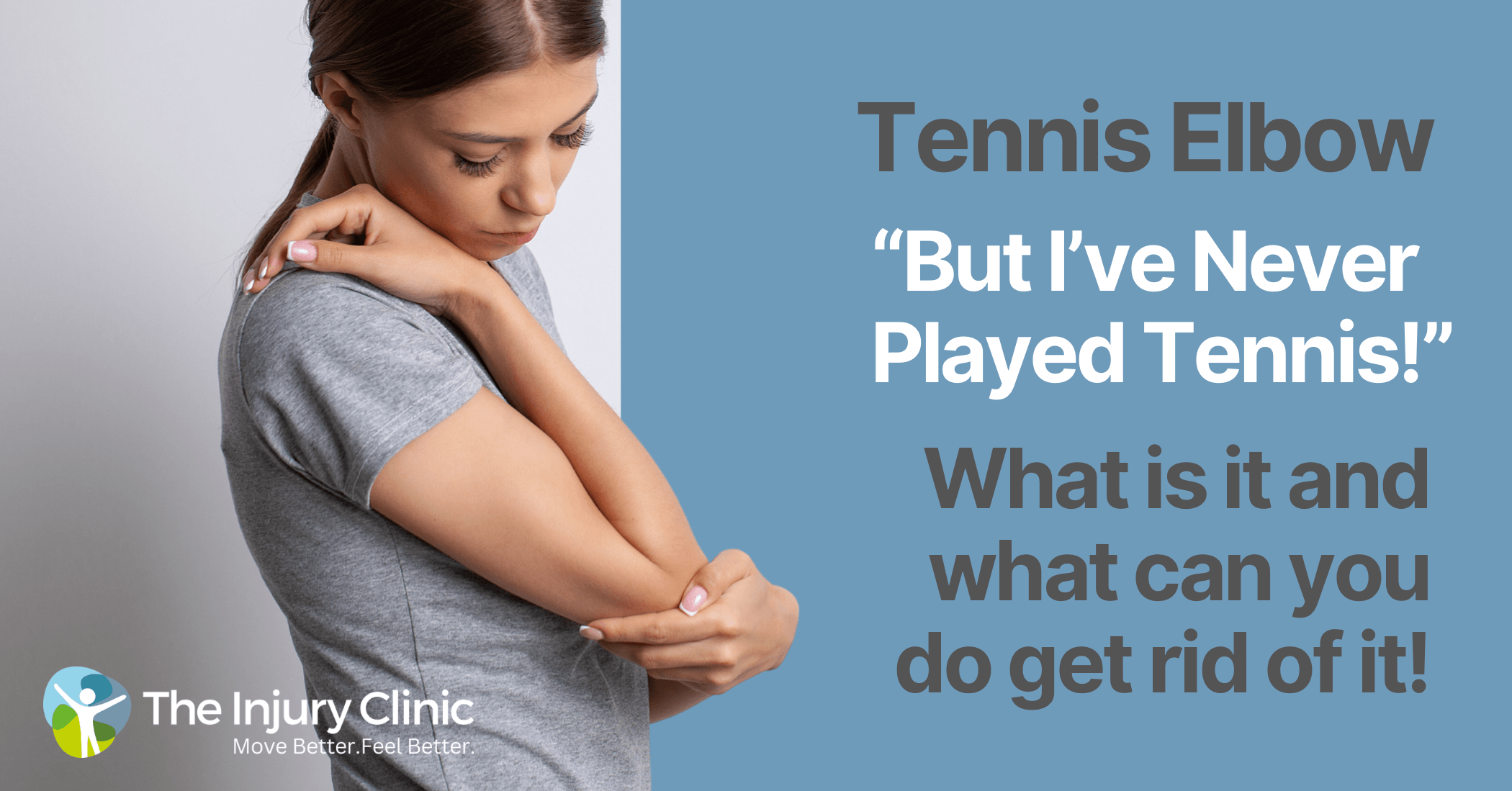
Tennis Elbow – “But I’ve Never Played Tennis!”
“I think I’ve got tennis elbow but I’ve never played tennis!” is a phrase I heard from a client just last week who had come to the clinic after suffering with pain in her elbow that hadn’t gone away after a few months.
Think this might also be you, even though you’ve never picked up a racket? Then you’re not alone. Pain on the outside of the elbow/forearm know as “Tennis Elbow”, or “Lateral Epicondylitis” to give it it’s medical name, is estimated to affect 1 in 3 people with only around 5% attributed to actually playing tennis.
So, if it’s not tennis then what could be causing your tennis elbow? Read on to understand more about tennis elbow, common causes, why it often reoccurs and more importantly, what can be done to get rid of it once and for all!
Tennis Elbow
What is it?
Plantar fasciitis is a condition which affects the thick band of connective tissue running along the sole of the foot from the heel to the toes. The role of the plantar fascia is to provide strong support to the arch of the foot to increase foot and ankle stability during activities involving standing and walking. When excessively or repetitively stressed, this band of tissue can become irritated and painful. Due to the length of the plantar fascia these symptoms can be experienced underneath the heel, in the arch of the foot or on the back of the heel.
Tennis elbow (lateral epicondylitis) is the most common overuse injury affecting the elbow. The term lateral epicondylitis indicates that this condition affects the outside of the elbow and is the result of inflammatory reaction or in more longterm cases micro-trauma in the tendon. Symptoms of tennis elbow can typically be experienced from 2 weeks up to 2 years, with most cases being resolved within 1 year.
Symptoms
As tennis elbow is an overuse condition that develops over time, symptoms can vary dependant on the stage of injury.
The four stages of the development of lateral epicondylitis are defined by the following symptoms;
- Faint pain a couple of hours after the provoking activity.
- Paint at the end of or immediately after the provoking activity.
- Pain during the provoking activity, which intensifies once you have stopped the activity.
- Constant pain, which prevents the ability to perform activity involving the affected arm.
The most common complaints associated with tennis elbow include;
- Pain located around the outside of the elbow with a ‘dull ache’ into the forearm
- Tenderness around the outside of the elbow when pressed.
- Reduction in strength which is often reported as weakness in grip strength or fatigue in the arm.
- Stiffness and difficulty straightening the arm after periods of inactivity or first thing in the morning.
Causes
Tennis elbow develops when muscles and tendons in the elbow and forearm are subjected to overuse or through receptive tasks. The main muscles involved originate at the elbow, run down the forearm and insert around the wrist. This means any repetitive movements involving the wrist, forearm and elbow such as typing, twisting and lifting weight can cause the development of tennis elbow.
Injury is often work related, especially for manual/office workers who perform repetitive movements and/or those handling weight regularly.
Common risk factors that increase the chance of developing tennis elbow include
- Handling tools heavier than 1kg
- Handling loads heavier than 20kg regularly throughout the day
- Repetitive movements for more than 2 hours per day
- Training errors
- Misalignments of the involved joints
- Flexibility problems
- Ageing
- Poor circulation
- Strength deficits and/or muscles imbalance
Tennis elbow is most common in 35-50 year olds and rarely occurs in both arms, the dominant arm has the greatest chance of occurrence; however starting a new repetitive task with your weaker arm is also a common cause in the cases we see in the clinic.
Common Myths
You can only get tennis elbow if you play tennis…. False!
As we’ve already established this isn’t the case. There is a greater chance you can sustain tennis elbow from daily and work activities than there is from playing tennis!
You have to completely rest when you have tennis elbow… False!
Although activities will need to be modified to prevent further aggravation, strengthening exercises are encouraged through a home exercise programme to re-structure and gradually load the damaged tendons.
Tennis elbow clears up on its own … False!
While minor faint discomfort that has been there for a few day/week may well clear up if the aggravating activity is stopped altogether the majority of tennis elbow case will not settle without intervention, in fact the longer you have tennis elbow the less likely it is to resolve of it own accord and is often the main reason of reoccurrence over time.
How is it treated?
Most cases of tennis elbow are treated using conservative methods and there is no need for surgery. However, if conservative treatment fails after a minimum period of 6 months then surgery or injections can be considered.
Initial treatment is based on the principles of relieving pain and controlling inflammation. A steroid injection may be used alongside conservative treatment at this stage and has been found to have a beneficial effects lasting for approximately 3 months. However, this will not resolve the injury alone and after roughly 2 weeks rest following the injection, it is important that a gradual loading exercise programme is undertaken during this time.
Different types of therapies are used to treat tennis elbow, all with the same aim to reduce pain, load the tendon and improve function. Before undertaking any form of conservative treatment, it is important to gain a comprehensive understanding of how to control pain and which activities may need to be modified to avoid on-going aggravation of symptoms.
Common therapies include;
- Manual Therapy techniques to improve pain free range of movement
- Therapeutic ultrasound
- Taping techniques
- Shockwave therapy
- Deep tissue massage techniques
- Medial acupuncture
- An exercise programme including loading, strengthening and stretching
The modality we have found most beneficial for getting rid of tennis elbow with longer lasting results is a combination of specialist shockwave therapy with a personalised exercise loading program alongside. You can read more on that here.
What Can You Do?
In the early stage, applying ice for a maximum period of 15 minutes 3 times per day will help to reduce inflammation around the elbow and reduce pain. This may also reduce your pain, but don’t be fooled into thinking your tennis elbow has gone as reoccurrence rates with tendon issue are high if a structured recovery program is not followed.
Stretching the involved muscles around the elbow and wrist will reduce tension placed on the irritated tendons.
- Begin with your arm straight out in front of your with your palm facing up to the ceiling
- Using your other hand bend your wrist so your fingers are pointing towards the floor, you should feel a mild to moderate stretch in your forearm
- Hold for 10-20 seconds, repeat 3 times.
The best thing you can do for yourself is to avoid any aggravating movements that involve repetitive wrist, forearm and elbow actions. This may mean adapting daily or work activities!
If you’ve found the information in this article interesting and are wondering what else we can help you with? Or know someone that we could help (they’re usually the ones moaning to you about their issue) Then please feel free to get in touch with us here at the clinic and we’d be happy to help.
